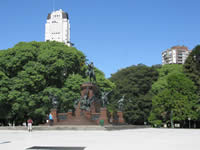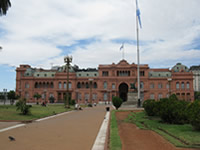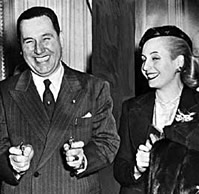INFORMATIONSPANISH COURSESSPANISH RESOURCESABOUT ARGENTINAVIDEOSOTHER RESOURCES |
HISTORY ARGENTINA Pre-Columbian
The earliest traces of human inhabitation dates from 11,00BC, although the indigenous cultures of Argentina were less-developed than those of neighbouring Peru. In 1AD, several cultures in the Andes developed maize-based civilzations, and later became part of the Inca Empire. Further south, the indigenous people remained mostly hunter-gatherers. Some of the most notable cultures include the Guarani in the northeast who farmed yuca and sweet potato and the Mapuche in the central areas who unified many of the nomadic cultures in the seventeenth century.
Colonial Era In 1516, Juan Diaz de Soliz, in search of a southwest passage to the East Indies, sailed into what is now known as the Rio de la Plata and claimed the area for Spain. Although Pedro de Mendoza founded Buenos Aires in 1536, they were forced to abandon the site five years later due to a series of hardiships and it was not until 1580 that Spain resettled Buenos Aires. Although Buenos Aires was a more direct link to Spain, the region was under the control of the Viceroyalty of Peru, based in Lima, and was closed to overseas trade. It was not until 1776 that Buenos Aires became the capital of the Viceroyalty of the Rio de la Plata, which consisted of modern day Argentina, Bolivia, Paraguay and Uraguay. As a result, the area began to prosper and grow through both a rigourous trade with Spain and its colonies, and an illegal trade, exporting Peruvian silver and cattle hides from the Pampas, and importing African slaves.
In 1516, Juan Diaz de Soliz, in search of a southwest passage to the East Indies, sailed into what is now known as the Rio de la Plata and claimed the area for Spain. Although Pedro de Mendoza founded Buenos Aires in 1536, they were forced to abandon the site five years later due to a series of hardiships and it was not until 1580 that Spain resettled Buenos Aires. Although Buenos Aires was a more direct link to Spain, the region was under the control of the Viceroyalty of Peru, based in Lima, and was closed to overseas trade. It was not until 1776 that Buenos Aires became the capital of the Viceroyalty of the Rio de la Plata, which consisted of modern day Argentina, Bolivia, Paraguay and Uraguay. As a result, the area began to prosper and grow through both a rigourous trade with Spain and its colonies, and an illegal trade, exporting Peruvian silver and cattle hides from the Pampas, and importing African slaves. Independence
Britain, which was at war against Spain and France at the time, attacked Buenos Aires in both 1806 and 1807 but a citizen militia defended the city. Filled with confidence in their abilities, the people of Buenos Aires refused to recognise Napolean's brother when he was installed as the King of Spain. Instead, they overthrew the government and established a provisional governing council in 1810. Campaigns were launched to win the support of the interiour of the country, a war for independence that would continue for years. In 1816 in Tucuman, formal independence was declared. However, a stable government was not established and the fighting between those that wanted a state centralized in Buenos Aires and those that wanted a federalist state with greater autonomy in the provinces ended in civil war. In 1829, the dictator Jan Manuel de Rosas took power and ruled with an iron hand until General Justo Jose de Urquiza deposed him in 1852.
The Confederacy and the Republic A year later in 1853, Argentina adopted a federal constitution, with Urquiza as the first president; Buenos Aires refused to recognise the Confederation and civil war errupted in 1859 and again in 1861. In the Battle of Pavon, the Buenos Aires forces, under the leadership of General Barolome Mitre, defeated the Confederation and the Republic of Argentina was created. Mitre became the president pledging to bring industrialisation and immigration to the country. From 1865 to 1870, in what became known as the War of the Triple Alliance, Argentina declared war against Paraguay in conjunction with Brazil and Uraguay. In 1879, General Julio A. Roca, in what is known as the Conquest of the Desert subdued the remaining indigenous tribes, killing over 1,300 people and opening the southern Pampas to new areas for grazing and farming.
A year later in 1853, Argentina adopted a federal constitution, with Urquiza as the first president; Buenos Aires refused to recognise the Confederation and civil war errupted in 1859 and again in 1861. In the Battle of Pavon, the Buenos Aires forces, under the leadership of General Barolome Mitre, defeated the Confederation and the Republic of Argentina was created. Mitre became the president pledging to bring industrialisation and immigration to the country. From 1865 to 1870, in what became known as the War of the Triple Alliance, Argentina declared war against Paraguay in conjunction with Brazil and Uraguay. In 1879, General Julio A. Roca, in what is known as the Conquest of the Desert subdued the remaining indigenous tribes, killing over 1,300 people and opening the southern Pampas to new areas for grazing and farming. The Dawn of the Modern Age
From this period until the onset of the First World War, Argentina continued to increase in prosperity, becoming one of the top ten richest countries in the world. Fueled by wool, wheat and beef exports, Buenos Aires filled with Parisian-like buildings and Argentina's population increased sixfold. In 1912, the Saenz Pena law granted universal male suffrage and the increased political participation of the middle and working classes brought Hipolito Irigoyen and the Radical Party to power in 1916. Though World War I brought about a recession, from 1924 until the world economic crisis of 1929, Argentina witnessed another burst of prosperity.
The Rise of Juan Peron In 1930, a military coup forced Irogoyen from power and installed a brief military dictatorship which ushered in another decade of conservative rule. Modern economic and political forces, including labour movements, the rise of a modern military and urbanisation played an important role in bringing to power Juan Domingo Peron and his Peronism. When the military ousted Argentina's constitutional government in 1943, Colonel Peron was promoted to Secretary of Wars. His populist power resulted, however, in the military arresting him without charge; subsequent mass protests lead to both his release and his victory in the elections on February 20, 1946. Although Argentina remained neutral for most of World War II, and the military governments from 1943-46 favoured the Axis powers, Argentina finally joined the Allied side towards the end of the war.
In 1930, a military coup forced Irogoyen from power and installed a brief military dictatorship which ushered in another decade of conservative rule. Modern economic and political forces, including labour movements, the rise of a modern military and urbanisation played an important role in bringing to power Juan Domingo Peron and his Peronism. When the military ousted Argentina's constitutional government in 1943, Colonel Peron was promoted to Secretary of Wars. His populist power resulted, however, in the military arresting him without charge; subsequent mass protests lead to both his release and his victory in the elections on February 20, 1946. Although Argentina remained neutral for most of World War II, and the military governments from 1943-46 favoured the Axis powers, Argentina finally joined the Allied side towards the end of the war.His wife, Evita Peron, was an actress from a working class background, whose evocative character helped to win the support of labour and women's groups. although she died of cancer in 1952. In 1947, Peron launched his first five-year plan to develop nationalized industries, and the same year women won the right to vote. Although Peron amended the constitution to run for a second term and won in 1952. After the June 1955 bombing of the Casa Rosada, Peron was deposed by a military coup and was forced into exile in Spain. Peronist vs. Anti-Peronist Forces
Eduardo Lonardi, who overthrew Peron, was quikly superceded by Pedro Aramburu. In 1956, two Peronist generals attempted a coup against the President; the uprising was crushed and the generals, members of the military and twenty civilians were executed in what became known as the Leon Suarez massacre. The same year, the anti-Peronist Radical Party won a majority; nonetheless, the left wing of the Radical Party under Arturo Frondizi, left the Constitutional Assembly in protest. In 1958, Frondizi won the election with the endorsement of Peron from Spain but was overthrown in 1962 by another military intervention. As Peronist worker protests continued, the government was faced with continued instability until in 1966 another coup established general Juan Carlos Ongania as the de facto president.
This system of military appointments continued until March 11, 1973 when Argentina held its first general elections in ten years. Although Peron was prevented from running, Peronist Dr. Hector Campora won the Presidency, resulting in a great outpouring of public support. Increasing pressure from both the right and the left lead Peron to return on June 20, 1973 and assume the presidency several months later; the date was marked by the Ezeiza massacre where at least thirteen were killed by gunfire at the airport where millions had gathered to welcome Peron. After Peron0's death on July 1,1974, his wife Isabel Peron assumed the presidency and was plagued by party in-fighting, a growing terrorist movement and economic disaster. The Dirty War
On March 24, 1976, a military coup evicted Isabel Peron from the presidency and the newly empowered junta began encouraging economic recovery through the "National Reorganization Process." It also took a harsh approach to eliminating the social base of the insurgency, targetting many middle class students, intellectuals and labour organizers. During 1976-1983, in what was known as the "Dirty War," estimates from 11,000 up to 30,000 people disappeared, that is, were arrested and summarily executed. In April 1977, the mothers of the disappeared began to speak out in the Plaza de Mayo, and continue to hold vigils today.
A Return to Democracy
The economic situation, rampant corruption, human rights violations and the defeat in the Falklands War by the United Kingdom in 1982 all played a role in discrediting the military regime. On October 30, 1983, Argentina held elections that were deemed fair and honest by international observers. Raul Alfonsin of the Radical Civic Union began his six year term as President in December, promptly forming the National Commission on the Disappearance of Persons while also granting amnesty to all acts committed before his term.
The Alfonsin government signed a peace treaty with Chile and laid the groundwork for Mercosur, but also struggled with increasing inflation, the consolidation of democratic institutions and establishing civilian control over the armed forces. In the end, the government left office six months early after the election of the Peronist Carlos Saul Menem in 1989. The '90s
Carlos Menem launched a vigourous, controversial neoliberal agenda, ironically privatising many of the industries that Peron had nationalised, In 1994, the Consitution was reformed, allowing him to run for an additional term. Though Menem won the election of 1995, a new FrePaSo alliance emerged which was an alternative to the two traditional parties, the Peronists and the Radicals. In 1999, the Radical-FrePaSo candidate, Fernando de la Rua, won and continued with the free market economic policies of the previous administration. De la Rua additionally launched initiatives to control the federal deficit, reform labour laws and stimulate the economy through promoting business.
The Argentine Economic Crisis
Despite these efforts, the results were catastrophic. The recession that had begun at the end of Menem's last turn ultimately lead to the Argentine economic crisis and the devaluation of the peso. Under pressure from the IMF to repay its external debt, Argentina was forced to devalue the Argentine peso which had until then been pegged to the U.S. dollar. In response to fears of capital flight, on November 1, 2001 the Minister of Economy, Domingo Cavallo, passed laws severely limiting bank withdrawls. This affected the middle class, effectively freezing their assets, while the upper class generally maintained their assets in dollar denominated bank accounts.
As the economy continued to decline at an alarming rate in December, Argentina saw the death of dozens of people from riots and the resignation of both the Minister of Economy and De la Rua. Although the National Congress promtely elected Adolfo Rodriguez Saa, he resigned a week later on December 31st. On January 2, 2002, the Peronist Eduardo Duhalde, who had lost in the most recent presidential election, was elected. Under his rule, the peso was devalued to 29% of the dollar, and ultimately the peg was abandoned completely. While President Duhalde was faced with protests from both the middle and lower classes and the sinking of millions of Argentinians into poverty, he conducted a relatively moderate economic policy, working to control inflation, increase industry, encourage import substitution and provide basic necessities. Elections were held the following year; the former President Carlos Menem withdrew from the elections bringing Nestor Kirchner of the Justicialist Party to power on 25 May, 2003. Previously the governor of Santa Cruz province but little know otherwise, Kirchner vowed a "cold wind of change." With a focus on accountability, he stood up to the military and police and repealed the general amnesty granted to those during the Dirty War. He also restructured Argentina's debt with great controversy and realigned Argentina's foreign policy away from the United States and towards Mercosur. On July 2, 2007, Kirchner announced that he would not seek reelection. In October 2007, Cristina Fernandez de Kirchner, Nestor Kirchner's wife, won the election by one of the largest margins since Argentina's return to democracy, becoming the first elected female president (the first unelected one was Isabel Peron). The first days of her presidency were marked by a serious deterioration in U.S-Argentine relations as a result of a scandal involving illegal campaign contributions made by a U.S. assistant attorney. Fernandez de Kirchner has received reasonably high approval ratings and expected to provide continuity from the previous administration. |
|
STUDY SPANISH ARGENTINA
©2008 - 2025 studyspanishargentina.Com - Learn Spanish Language in Argentina
Spanish immersion courses in Buenos Aires, Argentina
Spanish immersion courses in Buenos Aires, Argentina
